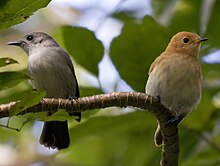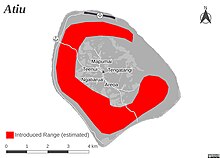| Rarotonga monarch | |
|---|---|

| |
| Adult | |

| |
| Left: at least 4 years old. Right: under 1 year old | |
| Conservation status | |
 Vulnerable (IUCN 3.1) | |
| Scientific classification | |
| Domain: | Eukaryota |
| Kingdom: | Animalia |
| Phylum: | Chordata |
| Class: | Aves |
| Order: | Passeriformes |
| Family: | Monarchidae |
| Genus: | Pomarea |
| Species: | P. dimidiata |
| Binomial name | |
| Pomarea dimidiata (Hartlaub & Finsch, 1871) | |

| |
| The resident range within Rarotonga. An introduced range also exists on Atiu island.
Resident range Introduced range | |

| |
| Synonyms | |
| |
The Rarotonga monarch (Pomarea dimidiata), also known as the Rarotonga flycatcher or Kākerōri, is a species of bird in the monarch flycatcher family Monarchidae. It is endemic to Rarotonga, Cook Islands, and has been introduced to Atiu, Cook Islands.
Taxonomy and systematics
The Rarotonga monarch was originally described in the genus Monarcha. Alternate names include Cook Island flycatcher, Cook Islands monarch, Kakerori, and Rarotonga monarch-flycatcher.
Description
The Rarotonga monarch is an insectivorous passerine which is 10 cm tall, with an adult mass of 20 grams (0.7 oz) for female birds, and 25 grams (0.9 oz) for large male birds. Hunting mainly consists of foraging for insects within foliage, and occasionally taking insects during flight.

The Rarotonga monarch is unusual as its plumage and beak undergoes a sequential colour change the bird matures. The initial plumage of orange changes to orange-grey mixed, then finally grey when maturity is reached, after four years. Initially, the grey and orange birds were attributed to different species. Later, it was thought that grey plumage birds were male, while the orange birds were females or juveniles of the same species, but this was corrected to being age-based plumage in 1983. Another bird in the Pomarea genus, the Fatu Hiva monarch, also undergoes a sequential colour change as it ages.
Behaviour and ecology
Owing to its tropical oceanic island location, the Rarotonga monarch is exceptionally long-lived having an adult survival of between 85 and 89 percent, a life expectancy of seven to nine years, and a maximum known lifespan of around 24 years and 8 months. These figures are comparable to large Australian passerines like the superb lyrebird or satin bowerbird and more than ten times the life expectancies of similar sized Holarctic songbirds.
Breeding
The extraordinary longevity of these birds may explain the evolution of helpers at the nest in a family where this feature is otherwise completely absent. Males can breed at one year, but do not do so in practice until they are four years old. Breeding season is between October to February, but most eggs are laid between October and Early November. Nests are mossy deep cups which are built in the fork of a tree branch, often constructed above creeks, and take about 14 days to build. Clutches are 1–2 eggs. In Rarotonga, many nest failures are attributed to predation by black rats or kiore, as birds sit on the nest.
Threats
Since the introduction of the black rat and feral cat, adult mortality has more than doubled; a change sufficient to reduce what was previously a highly numerous bird to one of the most endangered birds in the world by the middle 1980s, when the Rarotonga monarch was listed as one of the highest conservation priorities among all Pacific Island birds. The annual pre-breeding removal of rats (starting in the late 1980s) from its principal breeding area on the south coast of Rarotonga (at the Takitumu Conservation Area) by staff and volunteers has made breeding significantly more successful: around two thirds of pairs assisted by a few helpers can now rear the normal clutch of two eggs, whereas in the 1980s breeding attempts had a success rate as low as eleven percent. Despite the growth in population, a major tropical cyclone could destroy this population growth with extreme swiftness, so that conservation work is still very important.
Status
In the 1989, the total population was estimated at fewer than 29 birds in the wild, and was critically endangered but has recovered since annual rat bait laying during the breeding season. The Rarotonga monarch was limited to Rarotonga until a second population was established on Atiu Island by translocating 30 young birds in 2001, to establish an 'insurance population', should the Rarotongan bird population suffer a catastrophe.
In 2022 the total species population was assessed at 500 mature birds, and is now regarded as vulnerable. This reversal in conservation status is regarded as a major success story for South Pacific bird conservation efforts, with the Takitumu Conservation Area project receiving a Conversation Award by Birdlife International in 2022.
References
- BirdLife International (2018). "Pomarea dimidiata". IUCN Red List of Threatened Species. 2018: e.T22707172A132072143. doi:10.2305/IUCN.UK.2018-2.RLTS.T22707172A132072143.en. Retrieved 16 November 2021.
- "Rarotonga Flycatcher". Cook Islands Biodiversity & Natural Heritage. Retrieved 7 March 2013.
- ^ Sanders, Kerry H. (1993). The ecology of the kākerōri (Rarotonga flycatcher) Pomarea dimidiata, with special reference to fledged young : a thesis presented in partial fulfilment of the requirements for the degree of Master of Science in Ecology at Massey University (Thesis thesis). Massey University.
- ^ "Age and sex determination of Kakerori Pomarea dimidiata". Birds New Zealand. Retrieved 3 September 2023.
- Gill, William Wyatt (1885). Jottings from the Pacific. Religious Tract Society. pp. 127–128.
- ^ “Conservation of kakerori (Pomarea dimidiata) in the Cook Islands in 2004–05”
- "Saving the Fatu Hiva monarch from the brink of extinction". www.aucklandzoo.co.nz. 28 March 2019. Retrieved 3 December 2024.
- "Biology – Kakerori Bird | Cook Islands". Retrieved 16 September 2023.
- See Australian Bird and Bat Banding Scheme
- Distribution of known and inferred modes of parental care in families and subfamilies of birds
- ^ "Breeding biology of the Kakerori ( Pomarea dimidiata ) on Rarotonga, Cook Islands". Birds New Zealand. Retrieved 16 September 2023.
- "Biology – Kakerori Bird | Cook Islands". Retrieved 3 September 2023.
- ^ Takitumu Conservation Area Management Plan 2020–2030 (PDF). pp. 38, 23–24.
- Sherley, Greg. "Bird Conservation Priorities and a draft [avifauna] Conservation Strategy for the Pacific Islands region / compiled by Greg Sherley". library.sprep.org. Retrieved 16 September 2023.
- Department of Conservation (22 July 2022). "Hugh helping to bring back the kākerōri | Conservation blog". blog.doc.govt.nz. Retrieved 16 September 2023.
- ^ Matthew Littlewood (22 September 2022). "Kākerōri revitalisation project wins major conservation award". Cook Islands News. Retrieved 23 September 2022.
- Robertson, Hugh A.; Karika, Ian; Saul, Edward K. (2006). "Translocation of Rarotonga Monarchs Pomarea dimidiata within the southern Cook Islands". Bird Conservation International. 16 (3): 197–215. doi:10.1017/S0959270906000268. ISSN 1474-0001.
- Peter de Graaf (4 November 2018). "Cook Islands: The Birdman of Atiu". New Zealand Herald. Retrieved 8 February 2021.
- "Rarotonga Monarch (Pomarea dimidiata) - BirdLife species factsheet". datazone.birdlife.org. Retrieved 16 September 2023.
External links
- BirdLife Species Factsheet.
- Kākerōri Conservation Project Bird Biology Page
- Cornell Lab of Ornithology, Birds of the World: Rarotonga Monarch
| Taxon identifiers | |
|---|---|
| Pomarea dimidiata |
|